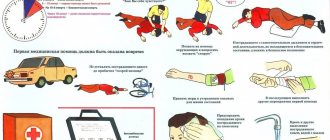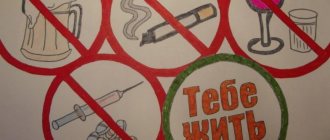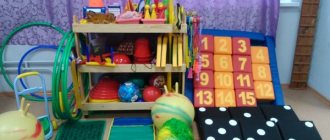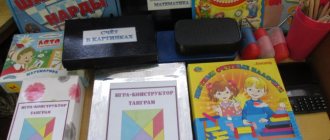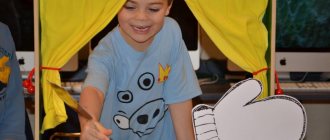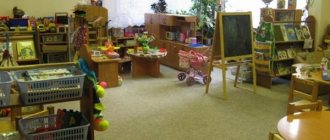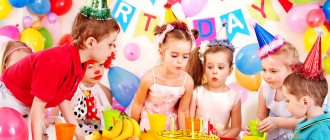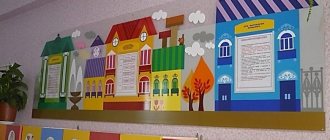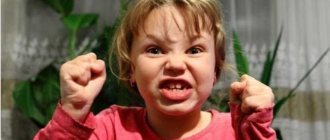Corner of Fine Arts and Creativity (senior preparatory group)
Daria
Fine Arts and Creativity Corner (senior preparatory group)
We have updated the sculpting materials. We purchased modeling kits (for a dentist appointment, make a castle and a dress for a princess, a cake factory); plasticine (floating, ball, soft)
; modeling dough, molds, stacks
Kinetic sand was also purchased, and sand for creating applications and murals
In our creativity corner there is a variety of visual materials (colored pencils; felt-tip pens; air markers; watercolor markers; stamps; stained glass paints; watercolor paints; gouache; stencils; blotography tubes, plastic forks, toothbrushes; cotton swabs ( for non-traditional methods of drawing)
; wax crayons, colored crayons, sharpeners, erasers and much more. etc.).
Didactic games, manuals, and materials for learning about folk arts and crafts have been updated.
Didactic games for the development of creative abilities , the formation of color perception, and familiarization with painting genres.
D/I “Choose a palette.” Goal: find the palette on which the artist mixed paints when painting the seasons (summer, autumn, winter, spring)
.
D/I “Name the color of the season”
D/I “Assemble a still life”
Creator 's Kit
Natural materials for manual labor
And in the reception area there is a self-made magnetic stand “Our Creativity ”
Experimentation corner (senior group) Preschoolers are born researchers. And this is confirmed by their curiosity, constant desire to experiment, desire to independently. Competitive program “March 8 is a holiday for mothers” (senior preparatory group) Competitive program: “March 8 is a holiday for mothers.” Preliminary work with children: Draw a portrait of grandmothers and mothers - gouache drawing Composition.
ECD on ecology “Miracle in Feathers” (senior and preparatory group) A spring melody sounds. Educator: The earth is awakening from winter dreams. the sunlight is bright, dazzling, reflected in the running streams.
Entertainment “Zebra's Birthday” (senior and preparatory group) Goals and objectives: carried out with the aim of increasing the culture of behavior on the roads among preschoolers of the senior and preparatory groups. Objectives: 1. attraction.
Report “Nature Corner - the center for the formation of elementary ideas about the natural environment” (senior group) Report “Nature Corner - the center for the formation of elementary ideas about the natural environment” senior group No. 2 Report “Nature Corner - the center.
Scenario of entertainment for Maslenitsa in kindergarten (preparatory and senior group) Goal: to cultivate a love for the traditions of the Russian people, poetry, beauty. Progress of entertainment I. Introductory part. Ved. Hello, guests.
Sports leisure by February 23 (senior, preparatory group) Goal: To cultivate respect and a sense of gratitude for the people who defend their homeland. Develop speed, agility, technique of performing basic movements, ability.
Wall newspaper for March 8 “Heart in the palms” senior preparatory group Very soon the spring holiday of March 8 will come. The children and I came up with the idea of congratulating our mothers using a wall newspaper. Let it always be female.
Source
Speech development corner in kindergarten - design according to the Federal State Educational Standard, examples
Mastering oral speech is an important process in the development of a child’s personal qualities. The preschooler’s active vocabulary is replenished, the ability to ask questions, formulate thoughts and draw conclusions develops. The formation and improvement of speech skills is carried out simultaneously with the development of mental and psycho-emotional abilities. Speech is a tool in research and creative activity, an opportunity to communicate with peers and adults.
Creation and work of a speech development corner in kindergarten: role, significance, goals and objectives
The child’s speech develops gradually. By the age of 1.5 years, the first simple sentences appear: “Give me a drink,” “Give me,” etc. By the age of three, the vocabulary is approximately 1,500 words, the child composes complex sentences, uses conjunctions, and comes up with new words. Thus, already in the younger groups of kindergarten, increased attention is paid to speech classes with children.
It is necessary to pay attention to speech development from an early age of the child.
The process of speech acquisition is a complex process that occurs in all types of children's activities. The Federal State Educational Standard (FSES) identifies a separate area - “Speech development” - and puts forward requirements for the work of a teacher in this area. In addition to developing and conducting standard and integrated speech classes, the teacher of a preschool educational institution is tasked with organizing the subject-spatial environment in the group. In order to develop and, if necessary, correct the speech skills of pupils of all ages, several corners are set up - book, speech therapy, theatrical and speech.
Speech development of pupils is carried out in standard classes
The speech corner involves conducting classes individually and in subgroups of 2-3 students. It also becomes one of the centers of children’s independent activity; they are pleased and interested in studying visual materials and playing here. The purpose of creating a corner for speech development is the optimal organization of a developmental environment for improving the speech abilities of pupils.
The materials and design of the speech corner are attractive to children and arouse interest.
The tasks of the speech corner directly depend on the age and individual characteristics of the children.
Table: tasks of the speech corner
The purpose of speech exercises is to develop facial and articulatory skills
Making a speech corner with your own hands
The speech development center is equipped and staffed in accordance with the age of the pupils. Thus, every year it is transformed and enriched to make it interesting and productive for children to study here.
For younger preschoolers, the speech development corner may include a sensory area - a place for the development of fine motor skills. As an option, this is a table with educational games: pyramids, a sorter, books and toys with buttons, bags for seeds and pebbles.
In the speech corner of the younger group, you can arrange a table with games for the development of sensory perception
Or it’s a rug on the wall with beepers, rubber bands, a plastic mirror, buttons, felt pictures, ribbons, and Velcro. The sensory mat usually depicts the plot of a fairy tale familiar to children (“Turnip”, “Teremok”, “The Three Little Pigs”) or images of natural objects, animals: flowers, trees, butterflies, birds, bunnies, etc. Everyone knows that a child’s first he actually wants to touch the object that interests him, so a developmental rug is made from pieces of bright fabric, scraps of velvet, printed ribbon, and colorful braid.
Fun images on the rug attract children and encourage active sensory perception of textile images
In recent years, busy boards have become popular as equipment for sensory development - boards or stands with objects attached to them, which small children are usually forbidden to touch. It is easy to make a business board with your own hands: various locks (latch, door hook, latch), bicycle and door bells, buttons and switches are glued or screwed onto a plywood sheet.
The development of sensory perception and fine motor skills is facilitated by the study of the so-called. "busy boards"
For all age groups of preschoolers, objects and play sets for the development of speech breathing should be presented in the corner. For these purposes, waste material and simple toys are used: plastic tubes and cups, ping-pong balls, cotton balls, plumes and pinwheels, flags, balloons. The teacher includes breathing exercises in play activities: “Put the ball into the goal”, “Raise the sails!”, “Shallow, shallow, mill!”.
Simple materials were used to create the game: cardboard, colored paper and cotton balls.
In the speech corner of the senior and preparatory groups, a place is set up for board and printed games. The selection is made up of games with letters and words:
- “Entertaining ABC”: for cards with letters (uppercase and printed), you need to select cards with images of objects for these letters.
- “ABC Lotto”: cards with beeches are filled with chips with animals whose names begin with these letters.
- “Kaleidoscope of Letters”: children learn to recognize the symbolic designations of letters on the playing field.
- “Make a word. Dominoes: cards are used to create an image and its name.
- “Who lives where”: cards with words, animals and their habitats.
Such games teach children to add syllables and words, as well as develop speech abilities in group play.
To stimulate children's verbal creativity and play dramatization games, a small area with a screen, decorations, and dolls is set up in the corner. Unlike the theatrical activity corner, the space for performances in the speech corner is limited. For example, you can cover a cardboard box - it will be a fairy-tale forest for the figurines. Dialogue using hand puppets and bibabo can be acted out from behind a folding paper screen.
Dolls and decorations stimulate children's independent speech creativity
Requirements for the speech development corner according to the Federal State Educational Standard for Preschool Education
- Optimal location: the corner is sufficiently lit, located in a quiet place next to the book, theater and sensory development corners.
- Compliance with the age and individual needs of children.
- The presence of an animated character - a doll or toy. The character who owns the corner encourages children to engage in speech activity: he tells funny stories, invites them to play, and asks questions. With the help of an animated toy, motor exercises and articulatory gymnastics are demonstrated.
- Aesthetics. The corner is designed in the same style as the areas for artistic reading and theatrical activities. The place of study attracts not only with bright colors, but also with interesting objects: reproductions on the wall, figurines on the shelf. Didactic and gaming materials are located in a corner by topic, and students learn to maintain order.
- Safety. Pupils of the first and second junior groups independently practice the development of fine motor skills under the supervision of a teacher (due to the danger of small parts getting into the respiratory tract). It is not recommended to equip the speech corner with hanging shelves or cabinets with glass doors. Electrical appliances and power supplies must be out of the reach of children.
An example of designing a speech corner in the middle group - video
Speech Corner Passport
A kindergarten corner passport is an information document that describes the state of the activity center, equipment and subject content. The passport is drawn up by the teacher and certified by the administration of the preschool educational institution, stored in the teacher’s document folder or in a special cell in the corner. Colleagues, young professionals, and parents of students can get acquainted with information about the contents of the corner. A passport is required to nominate a corner for a competition of pedagogical projects to organize a subject-development environment for children.
Sample speech corner passport template:
- Name of the corner, age group.
- Tasks of the corner (briefly).
- Furniture items, quantity.
- Electrical appliances, if any (audio player, projector).
- List of visual teaching aids (posters, mnemonic tables).
- List of demonstration materials (thematic pictures, cards-schemes).
- Didactic and board games.
- Sets for breathing exercises and dramatization games.
- Card file of speech exercises and games.
Fragment of the passport of the corner for speech development: visual, didactic and demonstration materials - table
How to name the corner of speech development
The name of the developmental activity corner in kindergarten should be short and understandable. Traditionally, the activity center is named after the actual focus of the activity. Since a mandatory attribute of a speech corner is an animated toy, the name of this fantasy character is often used in the name. Unusual and funny names arouse additional interest among students. You can arrange a competition for children and parents to come up with a name.
- Classic names: “Speech Corner”, “Speech Coach”, “Speech Development Corner”, “Learning to Talk”, “Speech Development Lessons”.
The traditional name reflects the direction of development of children's abilities in the corner - Titles with the name of the owner of the corner: “Lessons of Aunt Owl”, “Hello, Dunno!”, “Visiting Luntik”, “Button Invites”, “Talker”, “Mushka the Talker”, “Bunny the Lopotushka”.
The corner is named after an animated character - the hare Govorushi - Funny names: “Let's Talk”, “Gazebo”, “Zvukarik”, “Govoryashka/Govorusha”, “Azbukvarik”, “ABVGDEyka”, “Govorilki”, “Logostrana”, “Let’s Sit and Talk”, “Rechetsvetik”.
Funny names attract children to explore the corner
Speech Corner Design Tools
The corner is organized in the group’s premises with the aim of developing children’s speech abilities and, by its design, encourages pupils to express opinions, joint discussions, and conversations. Both children and their parents are involved in drawing posters, wall newspapers and pictures.
Plates and emblems - photo gallery
Signs for all corners of the group can be made according to a single template. The sign can depict a favorite character to attract the attention of children. The sign is attractive and evokes a positive attitude towards activities in the corner. The sign contains the original name of the corner and an image of its owner.
Signs and emblems with the name of the corner are a mandatory element. design: they indicate the direction of educational activity, contain the name and sometimes an image of a character beloved by children. It would be aesthetically sound to make a plate in the same style for all activity zones in a group, or to maintain uniformity in the logos of speech development centers.
Pictures - photo gallery
Drawings can represent animated characters that give children speech exercises. Images of fairy-tale characters decorate the walls of the corner. Pictures based on children’s favorite fairy tales serve both as decoration for the corner and as materials for constructing a story. Pictures indicate one of the areas of work of the speech corner - familiarization with letters and sounds.
Pictures and drawings decorate the walls and furniture in the group’s premises. To design the speech development corner, images of fairy tale and cartoon characters, animals, and letters are used. At the same time, the pictures in the speech corner are functional; children can be asked a question about them or come up with a task aimed at developing oral speech: “Who is shown in the picture? Describe what he is like,” “Say hello to Dunno. Tell him how your day was,” “Come up with a short story based on this picture,” etc.
Stand - photo gallery
A stand with plastic cells is suitable for displaying information for parents and picture diagrams for children. On the stand, the teacher places didactic
Art corner in a group: helping children unleash their creative potential
Thematic zones in the group are a prerequisite for the harmonious all-round development of preschoolers. The richness of their content, together with suitable design, will allow children to gain a great experience during their stay in kindergarten. One of the favorite activities of both younger and older preschoolers is drawing. A bright and rich in materials art corner will interest children even more in creative activities.
The importance of the art corner in kindergarten
Most preschoolers love to draw. They really like art classes in kindergarten, and therefore, in their free time, the children are happy to repeat their drawings and crafts. Many people like to color ready-made pictures, for example, on a certain theme (for girls - fairy-tale princesses, and for boys - cars, planes, etc.). Some people are interested in looking at albums with reproductions of paintings and elegant folk crafts (matryoshka dolls, wooden spoons, dishes, trays).
Contents of the ISO corner in the group
The most important component of the art zone in a group is its capacity. First of all, these are direct materials for creativity.
When filling the corner with mandatory materials, the age of the students is taken into account. So, at a younger age, colored pencils and felt-tip pens in primary colors are sufficient: black, red, yellow, blue and green (the same applies to colored paper for appliqué). Further, the color range expands as children grow older.
Scissors are offered to children only in the middle group and under the supervision of a teacher.
New materials are added as they are mastered (for example, watercolors, sanguine and charcoal in the middle group). The same applies to materials for non-traditional art techniques (for example, after students in the junior group have mastered drawing with cotton swabs in class, the teacher places them in the art area).
Source
Guidelines for decorating a creativity corner
Zhanna Dilman
Guidelines for decorating a creativity corner
Guidelines for decorating a creativity corner
According to the modern educational standard (FSES),
the design of creativity centers in a group must meet the following requirements:
1. The corner is located in a well-lit area (near the window)
place.
2. The equipment meets the needs of the given age. After all, each age category is unique. For example, younger preschoolers are in the process of adaptation, so the teacher does not need to change the design . Children's attention should not be distracted by unnecessary details. In addition, the creativity corner should contribute to the development of children’s sensory skills. At an older age, conditions for self-expression are more important.
3. Materials for creativity and aesthetic development (for example, picture albums)
should be freely available to preschoolers so that they feel like
“masters”
in the group.
4. High aesthetics. A good corner attracts children's attention with its beautiful design . The guys should feel comfortable there. “childish” that is important
design - inclusion of
game characters in the design (pictures and dolls, creative works of students .
5. Multifunctionality. The gaming environment can be modified depending on the learning situation, combined with other zones. After all, groups are not very large rooms, so every meter must be used rationally Equipment and materials should be easily transformed to create a new game. For example, with the help of the creativity corner you can organize a role-playing game “In the artist’s workshop”
(combined with
the theatrical corner ) .
6. Variability. The equipment of the zone changes periodically: new material for creativity , children's demonstration works and design . In addition, conditions should be created the corner (for example, drawing, modeling, coloring pictures)
and group activities.
7. Safety and high quality of materials used in creating the zone. This applies to both furniture and means for directly equipping the corner (for example, scissors and glue should be stored in boxes with a lid)
.
8. Compliance with the gender principle. As you know, boys and girls have their own preferences. The teacher should take this point into account when selecting material in the creativity (in particular, offer coloring pages with cars, airplanes, robots and princesses, flowers, butterflies, etc.).
Occupancy of the creative center in groups :
1st early age group and 2nd early age group
Materials for creativity are given to children under the supervision of an adult.
Senior and preparatory groups
Paper of different sizes, shapes, textures and colors, colored pencils from 12 to 24 pcs, gouache 9-12 colors, watercolor 12-16 colors, jars for washing paint brush lint, fabric napkins, colored wax crayons, felt-tip pens, brushes, plasticine, stacks, modeling boards, oilcloths for covering tables, equipment for appliqué: scissors, paper of various sizes and colors, glue brushes, napkins, stencils for dishes, vegetables, fruits, etc. Silhouettes of animals, birds and humans, coloring books for girls and boys, materials on non-traditional drawing techniques: pokes, candles, toothbrushes, cotton swabs, stamps, samples of mixing paints (for example, white + red = pink, etc., the presence of diagrams of the sequence of drawing, sculpting, applications taking into account age and gender specifics.
Art corner in kindergarten
Drawing and modeling not only develop fine motor skills, stimulate imagination and imaginative thinking, but also teach you to compare the resulting result and the original, analyze the shape of objects and ways of conveying it. Creative activity forms in a child perseverance, determination, a desire to try something new, to express himself and show his vision of the world.
A striking example of how to properly design a fine arts corner in a kindergarten
Therefore, in the kindergarten group it is necessary to provide a place for artistic activities. A place where a child can independently engage in creativity should be characterized by the presence of all the necessary materials:
Reproductions of paintings, folk crafts (painted nesting dolls, clay toys, trays and patterned wooden spoons) and small plastic sculptures will help expand your understanding of the beauty of the surrounding world.
It is also important to provide a stand in the group to display children’s drawings and plasticine figures.
Important! Praise encourages the child to continue creating and he becomes more confident.
Decorating a corner in the junior group of a kindergarten with your own hands: Russian folk art
Decorating a corner in the junior group of the kindergarten “Russian Folk Art”
Author: Beloglazova Elena Aleksandrovna, teacher of the kindergarten “Alyonushka”, Novokuibyshevsk, Samara region. Description: this publication will be of interest to kindergarten teachers. Goal: Decorating a corner in the junior group of the kindergarten “Russian folk art” Objectives: - to introduce younger preschoolers to the origins of Russian folk art; — to involve parents of pupils in the design of the corner - “Russian folk art” My work as a kindergarten teacher began in the junior group, we got the group after kindergarten graduates, so the important point was the design of the group, the creation of a subject-spatial environment that would be comfortable and met the age requirements of children. Dear colleagues, I propose to your attention the design of the “Russian Folk Art” corner in the group. We all understand the importance of introducing children to the origins of national culture from an early age. Having explained to the parents of the pupils the importance of this area in the development and upbringing of their children, having received their approval and support, we began to design the corner. We allocated a place in the group so that it was open and accessible to children, and started decorating. Since the birch tree is a symbol of our Motherland, people wrote songs, proverbs and sayings about it, I chose it to decorate the wall. The birch trunk is made of whatman paper, which I bent and decorated, the leaves on the trees are made from ready-made decorative decorations, artificial leaves that I inserted on top.
As you can see, the first Russian antiquities appeared on the shelf: this is a samovar, which was given to us by the grandmother of one of the pupils, on which we hung a bunch of drying sacks. Next to the samovar we placed a loaf of salt dough made by our parents, (the loaf in the photo below) appeared jars, wooden spoons, and a matryoshka doll. And of course, the main decoration of the corner is our Russian beauty, in a red sundress, who is rightfully considered the owner of the corner, she was also given to us by our parents.
Our corner continued to take shape, and soon a Russian beauty appeared on the wall, leading a round dance around our birch tree. We designed the inscription for the corner “Russian folk art”, the letters were cut out of colored paper and glued to tape.
Soon, Russian folk instruments appeared in our corner: balalaika, accordion, bells, pipe, etc.
So gradually our corner was transformed. Due to new fire safety requirements, we slightly changed the design on the wall, we left the birch symbol, but now we painted two birch trees with paints, the inscription on the corner was also made with paint. Now our corner looks like this:
Together with parents, we continue to replenish and enrich our corner. For children, a folder was created with drawings for Russian folk tales, which were made by parents and children at home. Children love to look through the folder with drawings while in the corner and share their impressions of which fairy tale they like painted with my parents.
Here are some works: Fairy tale “Snow Maiden”
Fairy tale "Bubble, straw and bast shoe"
Fairy tale "Kolobok"
Together with my parents, poems and nursery rhymes about the nesting doll were decorated in the corner, in the form of a collection of “Matryoshka’s poems and nursery rhymes,” which I read to children during special moments.
This is not the end of the design of the “Russian Folk Art” corner in our group; we continue to replenish it and expand the material. I would be very grateful to hear your wishes and recommendations. Thank you all for your attention!
We recommend watching:
Physical education and health corner in kindergarten Do-it-yourself group and reception room decoration Welcome corner in kindergarten Do-it-yourself nature calendar in kindergarten
Similar articles:
DIY Autumn panel
Federal State Educational Standards requirements for creation and design in preschool educational institutions
According to the requirements of the educational standard, an activity corner must be provided in a well-lit place. Furniture and materials must be of high quality. The content of the corner should correspond to the age of preschool children, and creative materials must be changed from time to time or supplemented with new ones.
The most optimal furniture for a corner is a cabinet with open shelves on which you can place inspiring items (albums, reproductions of paintings), and isolate the materials necessary for creativity (paper, glue, scissors) from children and store them in a closed bedside table or drawers. Or it could be a table combined with a shelving unit.
For your information! For organized storage of all necessary materials (cardboard, paints, plasticine), you can use boxes of different colors or plain ones with bright symbols of the contents.
Drawing corner in kindergarten: DIY decoration
To attract the attention of children and inspire creativity, the art corner should be colorfully decorated, not forgetting the age of the children. In the younger group, it is not recommended to frequently change images, since at this age children are in the process of adaptation and any changes in the environment cause stress.
For your information! For children in the older group, it is important to support the initiative for creative self-expression - materials should always be available, and the teacher needs to create an atmosphere in which children consider themselves masters in the group.
To create a positive creative mood, you can draw or pin a picture on the wall - a fairy-tale castle from the land of creativity, a fairy-tale or cartoon character (little Raccoon, Pencil from Dunno, the cat Matroskin or Fixiki, etc.) with a palette, brush or pencil. The picture can also be changed, for example, after completing a topic or becoming familiar with new material or technique.
Pencil holders in the corner Fine art
An option for dotted design of a corner is possible - blots or silhouettes of children's hands pasted in different places, a rainbow due to clouds or drops of rain, a bright, catchy inscription, place paper holders in the shape of an animal on the shelves, a stand for brushes in the shape of a truck, pencils or glasses with funny faces.
Corner “Our creativity”. Design option for a creative corner for an exhibition of children's work
Oryshchenko Galina Andreevna
Corner “Our creativity”. Design option for a creative corner for an exhibition of children's work
Hello, dear colleagues, friends and just guests of my page! I present to your attention an option for designing a creative corner for an exhibition of children’s works in the reception area “ Our Creativity ”.
When we moved to a new group, we did not have a special corner for hanging our children's creative works . And then a brilliant idea came to my mind! Why not make a corner “ Creativity of our children ”
with your own hands! And this is what came of it!
To create it I needed:
• Paint “Ruduga-26”
for ceilings and walls
(for children's institutions)
water-based, acrylic white, matte, economical;
• Kohler paint of different colors;
• Clothespins or clips for fastening works ;
• Glue liquid nails + gun;
• Colorless acrylic varnish for finished works ;
• Wide wooden slats for decorating birch trunks ;
• Thin plywood for the tree crown;
• Artificial leaves for decorating tree foliage ;
• Decorative elements of butterflies and flowers to decorate the finished corner ;
The creative corner turned out to be bright and big! Children like to display their work on a stand and then look at it with their parents in the evening.
Analysis of the design and operation of the art corner
In kindergartens, competitions are often held for the best design of the art corner.
An example of furniture arrangement in the fine arts corner
However, any teacher can analyze the pictorial corner in the kindergarten - you just need to answer the following questions:
An art corner organized in a group in a kindergarten helps develop a child’s creative abilities, instill artistic taste and teach children to independently look for ways to depict their fantasies.
Source
Corner of creativity and fine arts. Art Centers
All kinds of creative corners, arranged on tables, cabinets, cabinets, or simply on window sills, are presented in the illustrated publications in this section.
See how your colleagues were able to competently and efficiently use the available space to optimally place their art corner for children. Special attention is paid to placing the necessary drawing supplies in it conveniently and in perfect order. Some of the materials are devoted to the design of stands for the “vernissage” of children’s works.
Ready-to-use ideas for arranging art corners.
Art corner “Fireworks of magical colors” in the middle group
Presentation of
the art corner “Fireworks of magical colors”
in the group
“Pochemuchki”
“Children should live in a world of beauty, games, fairy tales, music, drawing, fantasy and
creativity ” V.A.
Sukhomlinsky It is from this position that we try to organize the entire development space of our group. Joint activity of the teacher and the child in the creativity corner. The role of nursery rhymes in visual arts
Good afternoon everyone.
I would like to share my games and ideas for the creative corner in the first junior group.
I am attaching the goals and objectives of the toys I made to understand their connection with nursery rhymes and visual arts. A large turtle walked and trembled all over with fear. Publication “Project “Involving children in independent activities in the art corner. » Project “Involving children in independent activities in the arts and crafts corner through the production of Dymkovo folk toys” MBDOU “Kindergarten “Rodnichok”, Souzga village Completed by: Svetlana Nikolaevna Yurkina, teacher, IKK Relevance of the project topic: the project is aimed at stimulating children.
DIY creativity corner
Irina Serganova
Do-it-yourself creativity corner
Creativity corner (decoration)
in the second junior group.
Hello my dear friends, colleagues and just guests of my page of our favorite site! I hasten to share with you photos of the design of the creativity corner in my group . I try to decorate from available materials, such as cardboard boxes. This is a very good material not only for decoration, but also for kindergarten crafts.
At first it was just a table with two drawers, which was placed between the cabinet and the theater screen. The table was turned towards the wall with drawers so that children could not open them for safety reasons.
I bought a shelf at Fix Price on which I placed plastic cups with colored pencils.
I drove two nails into the wall, tied a string, and attached the children's work to clothespins.
The corner has everything you need for children's creativity : there is glue, brushes for glue and painting, stamps.
Stencils for tracing
Albums and a large number of coloring books for both girls and boys.
Colored paper, cardboard, plasticine, gouache.
Easel for drawing and exhibition of children's works.
This is the design I came up with for the children's creativity corner .
Thank you so much to all colleagues for your votes and support!
Do-it-yourself busy board A child who learns about the world around him strives to touch and try everything. To give them the opportunity to play with all sorts of things to their heart's content. Do-it-yourself busy board The child enjoys exploring the world around him. He is interested not only in toys, but also in all objects around that may pose a danger: DIY games Hello, SUMMER! So much sun! How much light! So much greenery all around! What is this? This SUMMER is finally rushing into our house. There is a diversity of songbirds. DIY felt painting of a corner of nature Hello, this time I would like to tell you about a visual aid I made with my own hands. Naturally, the idea is not new and is possible somewhere. Do-it-yourself carpet rug A carpet rug is a fascinating and unusual educational tool for children of any age. It can be used in groups and individually. Do-it-yourself laptop on traffic rules In connection with the implementation of the Federal State Educational Standard for preschool education, every teacher is looking for new approaches, ideas, forms and methods in their teaching activities.
DIY frame DIY frame. Objectives: Educational objectives: to expand students’ knowledge about the variety of crafts made from waste material; introduce the species.
Do-it-yourself theater A preschool child is a real listener, dreamer, researcher. When playing a fairy tale, children use various types of theater. Question. Do-it-yourself sensory development corner in an early age group Bondarenko I. A., Barsukova L. I. DS “Cosmos” Volgodonsk Sensory development of a small child is a necessary component for.
Source
